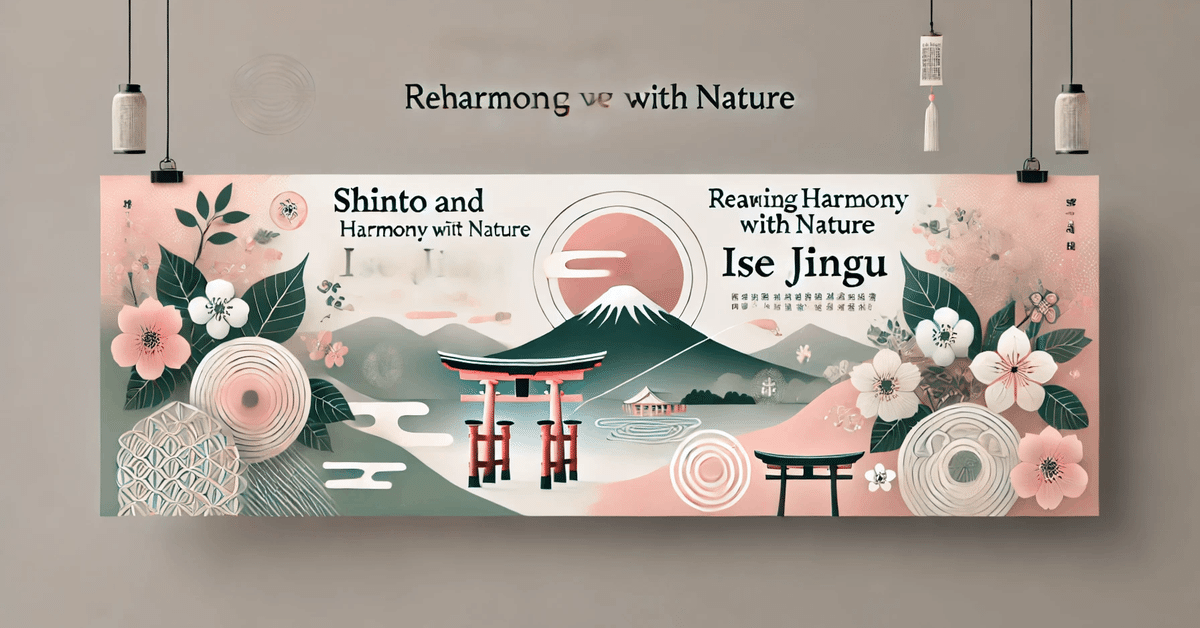
日本の自然観と神道の核心を学び、より深い文化的理解を:Discover the essence of Japan's connection with nature and Shintoism, and gain a deeper understanding of Japanese culture.
日本文化と神道の再認識
Japan's Culture and the Reawakening of Shintoism
伊勢神宮は、日本における最も神聖な場所の一つで、天照大神(あまてらすおおみかみ)を祀っています。天照大神は日本の古代文献『古事記』や『日本書紀』で太陽神として描かれ、日本の文化や生活における生命の源とされています。この神社は2000年以上にわたり、日本人の精神と自然との関係を象徴してきました。
Ise Jingu is one of Japan’s most sacred sites, dedicated to Amaterasu Omikami, the sun goddess. As described in Japan’s ancient texts Kojiki and Nihon Shoki, Amaterasu symbolizes the source of life in Japanese culture. For over 2,000 years, this shrine has represented the deep connection between the Japanese spirit and nature.
神道とは何か
What is Shinto?
神道は、自然の中に神々が宿るという、日本独自の宗教です。山、川、海、そして森に神が宿り、人間に恵みを与え、時に試練を課す存在とされています。この信仰は、日本人の「自然との調和」という考え方に深く根ざしており、日々の生活や祭りの中で受け継がれています。
Shinto is Japan’s indigenous religion, based on the belief that spirits, or kami, dwell within nature—mountains, rivers, seas, and forests. These spirits bestow blessings upon humans, sometimes even testing them. The essence of Shinto lies in living in harmony with nature, a value deeply embedded in Japanese daily life and rituals.
伊勢神宮と日本文化のつながり
The Connection Between Ise Jingu and Japanese Culture
伊勢神宮は、内宮と外宮の二つからなり、天照大神と豊受大神が祀られています。天照大神は命を象徴し、豊受大神は人々の暮らしを支える食物の神です。日本人の生活の基盤である「命」と「暮らし」の二つを象徴するこの神社は、日本の祭り文化の中心でもあります。伊勢神宮では、年間1500回以上の祭りが行われ、古代から続く儀式が今も守られています。
Ise Jingu is composed of two main shrines—Naiku and Geku—where Amaterasu Omikami and Toyouke Omikami are enshrined. Amaterasu represents life itself, while Toyouke is the deity of food and sustenance, essential for human livelihood. These two shrines symbolize the core of Japanese life—life and sustenance. As the heart of Japan’s festival culture, Ise Jingu hosts more than 1,500 annual ceremonies, continuing traditions that date back to ancient times.
西洋文化との違い
Differences From Western Culture
西洋文化の一神教と異なり、神道は多神教です。自然の中に多くの神々が宿り、人間がその調和を保つことが重要とされます。また、神道には「罪」や「罰」の概念が希薄で、「穢れ(けがれ)」という考え方が重視されます。穢れは、調和が乱れた状態を指し、祓いによって清められることで、再び調和が取り戻されます。
Unlike monotheistic Western religions, Shintoism is polytheistic, with numerous kami residing in nature. Rather than focusing on sin or punishment, Shinto emphasizes maintaining harmony. The concept of "kegare" (impurity) arises when this harmony is disturbed, and rituals of purification, called "harai," are performed to restore balance.
日本人と自然への調和の重要性
The Importance of Harmony With Nature for the Japanese
現代の日本では、多くの人々が神道や自然とのつながりを忘れつつあります。しかし、自然と共存し、感謝することは、私たちのアイデンティティを見直す機会となります。伊勢神宮のような場所は、私たちが自然との関係を再確認し、神々や先祖への感謝の心を思い出させてくれる貴重な存在です。
In modern Japan, many people are losing touch with Shintoism and their connection to nature. Yet, coexisting with and appreciating nature offers a chance to reflect on our identity. Sacred places like Ise Jingu remind us of our relationship with nature and renew our gratitude to the kami and our ancestors.
再認識の時
A Time for Reawakening
神道の価値を再認識し、自然の中に宿る神々に感謝する心を取り戻すことが、未来に向けた大切なステップです。自然と共に生きること、それが日本人の心の核心にあるべき姿です。
It’s time to reawaken the values of Shinto and reclaim our gratitude for the kami who dwell in nature. Living in harmony with nature is a path that lies at the heart of the Japanese spirit.
